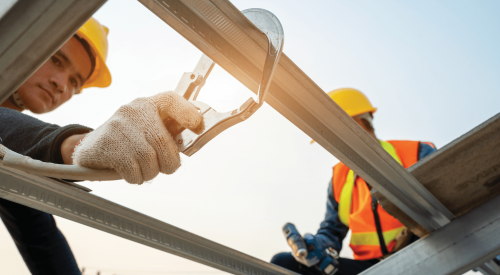|
"Where do I focus my attention to get the biggest return on my investment?" That's the question Bruce Thompson says all builders should ask themselves all the time. Thompson, an insurance broker, a longtime certified OSHA instructor and a member of the NAHB Safety Committee, says one of the answers is reducing workers’ compensation claims. How does a builder do that? Simple: safety.
"Focus your attention on employee and subcontractor injuries," says Thompson, who consults with large builders and helps them develop solid safety records that make them more attractive to insurance carriers. It's about more than just guardrails - a well-formulated, well-executed safety plan can lower insurance premiums.
Thompson says a good safety system has three basic components: training, auditing and documentation. Accident prevention training comes in many forms, the most basic of which is a 10- or eight-hour OSHA course tailored to residential construction and a builder's needs. Training needs to extend beyond a builder's employees to include all subcontractors, or at least their foremen. From there, Thompson says builders should follow up with specific training on hot topics regularly and frequently.
|
Mike Fallowfield, safety and claims manager for Lennar, agrees. In addition to OSHA training, every 10 working days Lennar workers attend a "tailgate meeting" on which they need to sign off.
Lennar's program also calls for a superintendent site inspection every 10 working days. Thompson says all builders need to audit compliance as well as spell out the consequences of noncompliance in a sub'’s contract. He also emphasizes rewards for compliance.
Training and auditing are worthless from a premium-reduction standpoint if they are not well-documented, both internally and by subcontractor foremen. Builders also need to get certificates of insurance from their subs naming the builder as an insured, with a 30-day cancellation notice.
The four basic job-site injury categories are falls, electrical, caught-in (as in an excavated hole or machinery) and housekeeping. Falls are the greatest concern because of the high rate of severe injuries. Thompson says a fall-related death claim is likely to be $250,000, minimum, and an injury that renders the victim quadriplegic could cost $4 million. Any kind of claim means premiums will go up and stay up for at least three years.
"Our biggest concern is building partners," Fallowfield says. "If injured on the job, they may file a lawsuit. Once you get into lawsuit status, there are no winners."
Housekeeping injuries (caused by a messy job site) generally aren't as severe as falls, but Thompson says they're vital because of their frequency. Housekeeping also is one of the easiest safety issues to manage.
Fallowfield stresses that safety must be a concern of every building company. "This is one of the most dangerous industries there is," he says. "The small builder must get involved." One or two workers' comp claims can put a small firm out of business.
Resources
|








